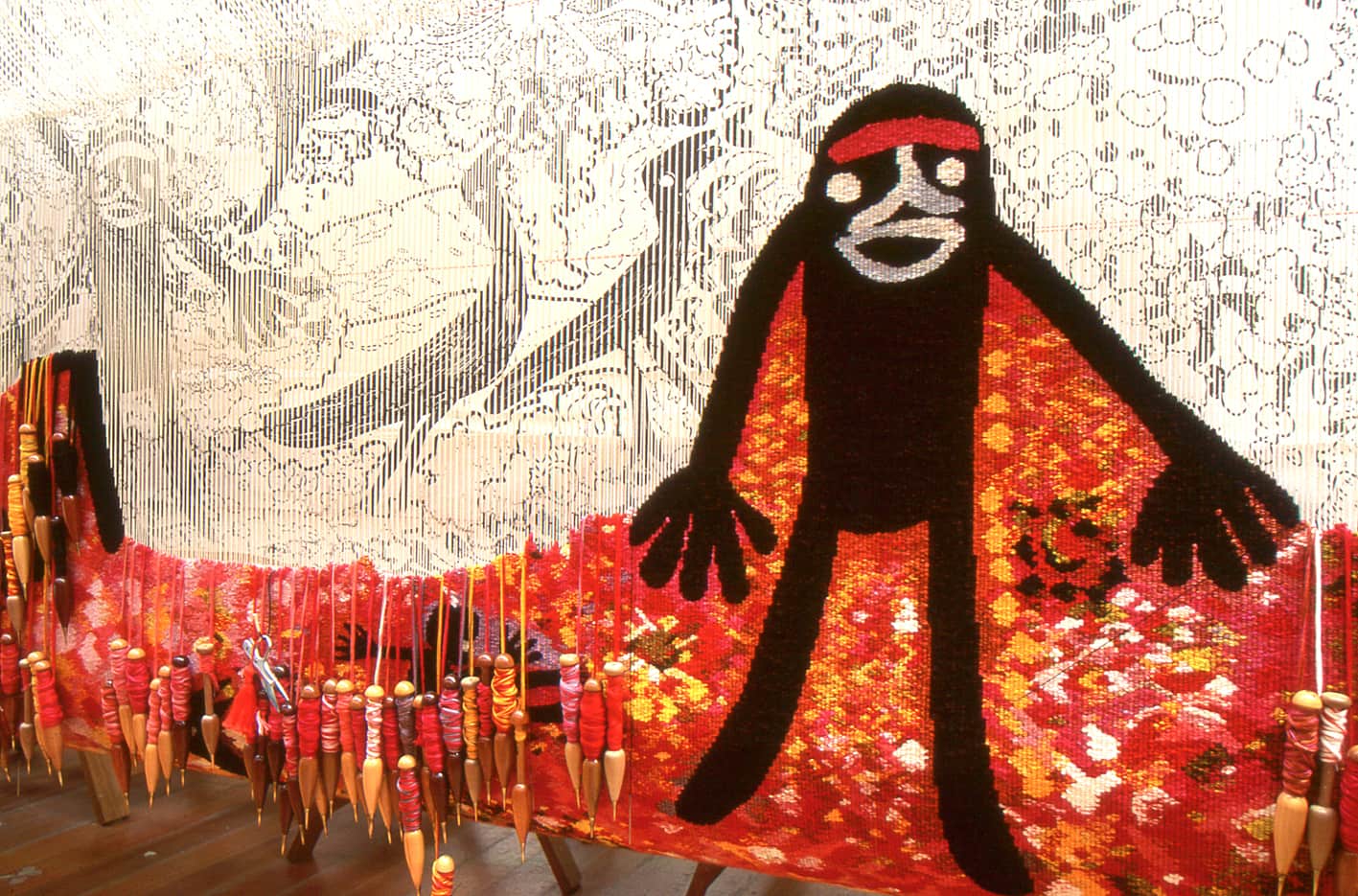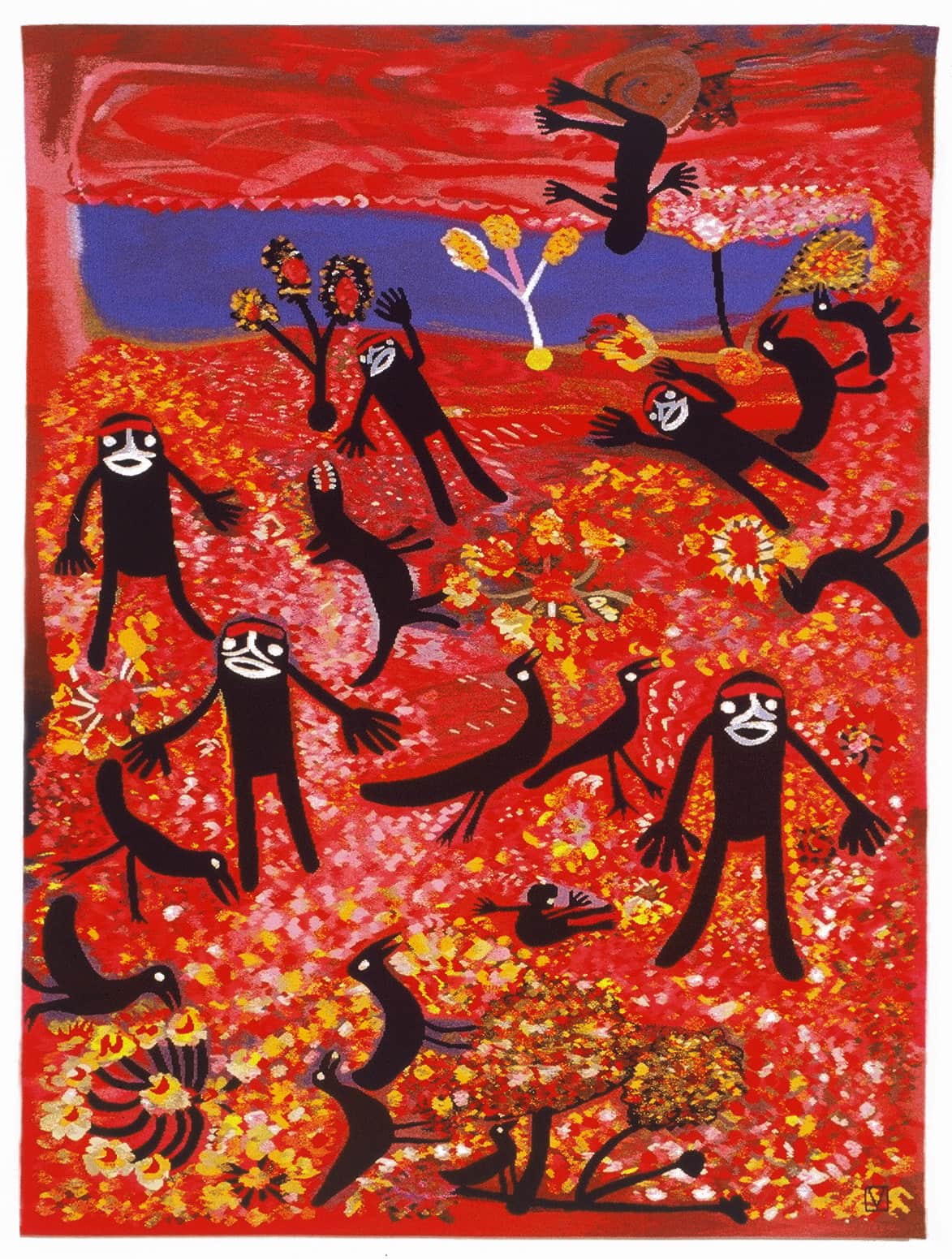

Panjiti Mary McLean, an elder of the Ngaatjajarra Aboriginal community from the Western Desert region in Central Australia, designed Painting at Kalkutjara, which was translated into tapestry by the ATW in 1998.
McLean’s paintings represent quotidian aspects of her community life, topographic features of the landscape, as well as the flora and fauna native to Ngaatjajarra, for example, bush foods like the quandong fruit. She works in a figurative tradition, her canvases replete with densely packed imagery teeming with life. McLean’s paintings often feature masses of tiny figures which seem to populate a fecund landscape, often intertwined with animal tracks or fields of flowers.
In Painting at Kaltukatjara, five figures with out-stretched arms are interspersed over a red ground, strewn with white and yellow flowers. ATW Weaver Irene Creedon was keen to capture the expressiveness of the ground in the image – the striking red of the earth contrasting with the dazzle of wildflowers – and used a strong palette to achieve this. The finished tapestry has a buoyant sense of vitality and, in its mesmerising harmony between humanity and nature, represents a condition of perfection, an idyll.
Panjiti Mary McLean’s work has been collected by all major Australian institutions.
Taking six ATW weavers almost 2 years to complete, the Aotea Tapestry, designed by Robert Ellis is a significant contemporary tapestry and one of the principle artworks in the Aotea Centre’s collection.
Ellis is a prominent British-born New Zealand painter who is concerned with social, cultural and environmental themes.
Speaking of the tapestry, Ellis noted: “It was not my intention to be too specific, as many people will prefer to interpret it in their own way. There are many different levels of meaning, depending on the viewer’s outlook.”
Robert Ellis’ work is held in many major institutions. He is represented by Milford Galleries in Dunedin.
The ATW produced the monumental Great Hall Tapestry, spanning 9.18 x 19.9m, and designed by prominent Australian artist Arthur Boyd, for Parliament House in Canberra in 1988.
Boyd (1920-1999) is considered to be one of Australia's most distinguished 20th-century artists. He came from the Boyd dynasty of painters, sculptors, ceramicists and architects, and was part of the Angry Penguins school in the 1940s and later the Antipodeans, which included John Perceval and Charles Blackman. Boyd represented Australia at the Venice Biennale in 1958 and again in 2000. In 1979 he was awarded an Order of Australia, augmented by a Companion of the Order of Australia in 1992.
The design of Parliament House in Canberra was won by architect Romaldo Giurgola in 1979, and created the opportunity for the commission of a major public artwork. As an eminent living artist Arthur Boyd was offered the chance to produce an artwork that would cover almost the entire south wall of the Reception Hall. Extensive discussions ensued about the best medium to suit this scale, and tapestry was decided on as the ideal choice.
The tapestry design represents a forest of towering eucalyptus trees from the grounds of Boyd's rural retreat and studio at Bundanon. The tree-scape is quintessentially Australian, a homage to the majesty of the bush. Strong vertical rhythms structure the work, and the life-like proportions of the trees recreate the enveloping feel of a forest setting, fulfilling the architect's brief that the entire wall would almost appear as a three-dimensional living landscape.
The massive scale of the work - an astonishing nine meters in height and almost twenty meters in width - makes it the second largest tapestry in the world. It was woven in vertical sections by 12 weavers over a two-year period, and remains the most ambitious tapestry the Workshop has ever produced.
Arthur Boyd’s legacy is maintained through the Bundanon Trust collection and many major collections in Australia and overseas.